Impact of the COL1A1 Gene Polymorphisms on Pain Perception in Tennis Elbow Patients: A Two-Year Prospective Cohort Study
Abstract
1. Introduction
2. Results
2.1. General Characteristics
2.2. Genetic Characteristics
2.3. COL1A1 Gene Polymorphisms and the Effectiveness of PRP Therapy
2.4. COL1A1 Gene Polymorphisms and Pain Before Therapy
2.5. COL1A1 Gene Polymorphisms and Potential Confounding Factors
3. Discussion
4. Materials and Methods
4.1. Study Design
4.2. Patients
4.3. PRP Separation and Injection Procedure
4.4. Follow-Up, Outcomes, Measures of Effectiveness
4.5. Genetic Analyses
4.6. Statistical Analyses
5. Conclusions
Supplementary Materials
Author Contributions
Funding
Institutional Review Board Statement
Informed Consent Statement
Data Availability Statement
Acknowledgments
Conflicts of Interest
References
- Riley, G. Tendinopathy—From basic science to treatment. Nat. Clin. Pract. Rheumatol. 2008, 4, 82–89. [Google Scholar] [CrossRef] [PubMed]
- Keijsers, R.; de Vos, R.J.; Kuijer, P.P.F.; van den Bekerom, M.P.; van der Woude, H.J.; Eygendaal, D. Tennis elbow. Shoulder Elb. 2019, 11, 384–392. [Google Scholar] [CrossRef] [PubMed]
- Millar, N.L.; Silbernagel, K.G.; Thorborg, K.; Kirwan, P.D.; Galatz, L.M.; Abrams, G.D.; Murrell, G.A.C.; McInnes, I.B.; Rodeo, S.A. Tendinopathy. Nat. Rev. Dis. Prim. 2021, 7, 1. [Google Scholar] [CrossRef] [PubMed]
- Kraus, A.; Sattler, D.; Wehland, M.; Luetzenberg, R.; Abuagela, N.; Infanger, M. Vascular Endothelial Growth Factor Enhances Proliferation of Human Tenocytes and Promotes Tenogenic Gene Expression. Plast. Reconstr. Surg. 2018, 142, 1240–1247. [Google Scholar] [CrossRef]
- Andrae, J.; Gallini, R.; Betsholtz, C. Role of platelet-derived growth factors in physiology and medicine. Genes Dev. 2008, 22, 1276–1312. [Google Scholar] [CrossRef]
- Boswell, S.G.; Cole, B.J.; Sundman, E.A.; Karas, V.; Fortier, L.A. Platelet-Rich Plasma: A Milieu of Bioactive Factors. Arthrosc. J. Arthrosc. Relat. Surg. 2012, 28, 429–439. [Google Scholar] [CrossRef]
- Wasker, S.V.Z.; Challoumas, D.; Weng, W.; Murrell, G.A.C.; Millar, N.L. Is neurogenic inflammation involved in tendinopathy? A systematic review. BMJ Open Sport Exerc. Med. 2023, 9, e001494. [Google Scholar] [CrossRef]
- Hackett, L.; Millar, N.L.; Lam, P.; Murrell, G.A. Are the Symptoms of Calcific Tendinitis Due to Neoinnervation and/or Neovascularization? J. Bone Jt. Surg. 2016, 98, 186–192. [Google Scholar] [CrossRef]
- Thankam, F.G.; Dilisio, M.F.; Gross, R.M.; Agrawal, D.K. Collagen I: A kingpin for rotator cuff tendon pathology. Am. J. Transl. Res. 2018, 10, 3291–3309. [Google Scholar]
- Ciardulli, M.C.; Scala, P.; Giudice, V.; Santoro, A.; Selleri, C.; Oliva, F.; Maffulli, N.; Porta, G.D. Stem Cells from Healthy and Tendinopathic Human Tendons: Morphology, Collagen and Cytokines Expression and Their Response to T3 Thyroid Hormone. Cells 2022, 11, 2545. [Google Scholar] [CrossRef]
- Thankam, F.G.; Boosani, C.S.; Dilisio, M.F.; Dietz, N.E.; Agrawal, D.K. MicroRNAs Associated with Shoulder Tendon Matrisome Disorganization in Glenohumeral Arthritis. PLoS ONE 2016, 11, e0168077. [Google Scholar] [CrossRef] [PubMed]
- Lin, T.W.; Cardenas, L.; Soslowsky, L.J. Biomechanics of tendon injury and repair. J. Biomech. 2004, 37, 865–877. [Google Scholar] [CrossRef] [PubMed]
- Servier Medical Art Resource. Available online: https://smart.servier.com/smart_image (accessed on 20 October 2024).
- Tromp, G.; Kuivaniemi, H.; Stacey, A.; Shikata, H.; Baldwin, C.T.; Jaenisch, R.; Prockop, D.J. Structure of a full-length cDNA clone for the prepro alpha 1(I) chain of human type I procollagen. Biochem. J. 1988, 253, 919–922. [Google Scholar] [CrossRef] [PubMed]
- de Wet, W.; Bernard, M.; Benson-Chanda, V.; Chu, M.L.; Dickson, L.; Weil, D.; Ramirez, F. Organization of the human pro-alpha 2(I) collagen gene. J. Biol. Chem. 1987, 262, 16032–16036. [Google Scholar] [CrossRef]
- Kuivaniemi, H.; Sabol, C.; Tromp, G.; Sippola-Thiele, M.; Prockop, D.J. A 19-base pair deletion in the pro-alpha 2(I) gene of type I procollagen that causes in-frame RNA splicing from exon 10 to exon 12 in a proband with atypical osteogenesis imperfecta and in his asymptomatic mother. J. Biol. Chem. 1988, 263, 11407–11413. [Google Scholar] [CrossRef]
- Online Mendelian Inheritance in Man® (OMIM). Available online: https://www.omim.org/entry/166710 (accessed on 10 October 2024).
- Online Mendelian Inheritance in Man® (OMIM). Available online: https://www.omim.org/entry/114000 (accessed on 10 October 2024).
- Online Mendelian Inheritance in Man® (OMIM). Available online: https://www.omim.org/entry/166200 (accessed on 10 October 2024).
- Online Mendelian Inheritance in Man® (OMIM). Available online: https://www.omim.org/entry/166210 (accessed on 10 October 2024).
- Online Mendelian Inheritance in Man® (OMIM). Available online: https://www.omim.org/entry/259420 (accessed on 10 October 2024).
- Online Mendelian Inheritance in Man® (OMIM). Available online: https://www.omim.org/entry/166220 (accessed on 10 October 2024).
- Online Mendelian Inheritance in Man® (OMIM). Available online: https://www.omim.org/entry/619115 (accessed on 10 October 2024).
- Online Mendelian Inheritance in Man® (OMIM). Available online: https://www.omim.org/entry/130060 (accessed on 10 October 2024).
- Grant, S.F.; Reid, D.M.; Blake, G.; Herd, R.; Fogelman, I.; Ralston, S.H. Reduced bone density and osteoporosis associated with a polymorphic Sp1 binding site in the collagen type I alpha 1 gene. Nat. Genet. 1996, 14, 203–205. [Google Scholar] [CrossRef]
- Khoschnau, S.; Melhus, H.; Jacobson, A.; Rahme, H.; Bengtsson, H.; Ribom, E.; Grundberg, E.; Mallmin, H.; Michaëlsson, K. Type I collagen alpha1 Sp1 polymorphism and the risk of cruciate ligament ruptures or shoulder dislocations. Am. J. Sports Med. 2008, 36, 2432–2436. [Google Scholar] [CrossRef]
- Posthumus, M.; September, A.V.; Keegan, M.; O’Cuinneagain, D.; Van der Merwe, W.; Schwellnus, M.P.; Collins, M. Genetic risk factors for anterior cruciate ligament ruptures: COL1A1 gene variant. Br. J. Sports Med. 2009, 43, 352–356. [Google Scholar] [CrossRef]
- Posthumus, M.; September, A.V.; Schwellnus, M.P.; Collins, M. Investigation of the Sp1-binding site polymorphism within the COL1A1 gene in participants with Achilles tendon injuries and controls. J. Sci. Med. Sport 2009, 12, 184–189. [Google Scholar] [CrossRef]
- Ficek, K.; Cieszczyk, P.; Kaczmarczyk, M.; Maciejewska-Karłowska, A.; Sawczuk, M.; Cholewinski, J.; Leonska-Duniec, A.; Stepien-Slodkowska, M.; Zarebska, A.; Stepto, N.K.; et al. Gene variants within the COL1A1 gene are associated with reduced anterior cruciate ligament injury in professional soccer players. J. Sci. Med. Sport 2013, 16, 396–400. [Google Scholar] [CrossRef]
- Stępien-Słodkowska, M.; Ficek, K.; Eider, J.; Leońska-Duniec, A.; Maciejewska-Karłowska, A.; Sawczuk, M.; Zarębska, A.; Jastrzębski, Z.; Grenda, A.; Kotarska, K.; et al. The +1245 g/t polymorphisms in the collagen type I alpha 1 (col1a1) gene in polish skiers with anterior cruciate ligament injury. Biol. Sport 2013, 30, 57–60. [Google Scholar] [CrossRef] [PubMed]
- Leźnicka, K.; Żyżniewska-Banaszak, E.; Gębska, M.; Machoy-Mokrzyńska, A.; Krajewska-Pędzik, A.; Maciejewska-Skrendo, A.; Leońska-Duniec, A. Interactions between Gene Variants within the COL1A1 and COL5A1 Genes and Musculoskeletal Injuries in Physically Active Caucasian. Genes 2021, 12, 1056. [Google Scholar] [CrossRef] [PubMed]
- Erduran, M.; Altinisik, J.; Meric, G.; Ates, O.; Ulusal, A.E.; Akseki, D. Is Sp1 binding site polymorphism within COL1A1 gene associated with tennis elbow? Gene 2014, 537, 308–311. [Google Scholar] [CrossRef] [PubMed]
- Sivertsen, E.A.; Haug, K.B.F.; Kristianslund, E.K.; Trøseid, A.S.; Parkkari, J.; Lehtimäki, T.; Mononen, N.; Pasanen, K.; Bahr, R. No Association Between Risk of Anterior Cruciate Ligament Rupture and Selected Candidate Collagen Gene Variants in Female Elite Athletes from High-Risk Team Sports. Am. J. Sports Med. 2019, 47, 52–58. [Google Scholar] [CrossRef] [PubMed]
- Dines, H.R.; Nixon, J.; Lockey, S.J.; Herbert, A.J.; Kipps, C.; Pedlar, C.R.; Day, S.H.; Heffernan, S.M.; Antrobus, M.R.; Brazier, J.; et al. Collagen Gene Polymorphisms Previously Associated with Resistance to Soft-Tissue Injury Are More Common in Competitive Runners Than Nonathletes. J. Strength Cond. Res. 2023, 37, 799–805. [Google Scholar] [CrossRef]
- Kaynak, M.; Nijman, F.; van Meurs, J.; Reijman, M.; Meuffels, D.E. Genetic Variants and Anterior Cruciate Ligament Rupture: A Systematic Review. Sports Med. 2017, 47, 1637–1650. [Google Scholar] [CrossRef]
- Wang, C.; Li, H.; Chen, K.; Wu, B.; Liu, H. Association of polymorphisms rs1800012 in COL1A1 with sports-related tendon and ligament injuries: A meta-analysis. Oncotarget 2017, 8, 27627–27634. [Google Scholar] [CrossRef]
- Van Pottelbergh, I.; Goemaere, S.; Nuytinck, L.; De Paepe, A.; Kaufman, J.M. Association of the type I collagen alpha1 Sp1 polymorphism, bone density and upper limb muscle strength in community-dwelling elderly men. Osteoporos. Int. 2001, 12, 895–901. [Google Scholar] [CrossRef]
- Baumert, P.; G-REX Consortium; Stewart, C.E.; Lake, M.J.; Drust, B.; Erskine, R.M. Variations of collagen-encoding genes are associated with exercise-induced muscle damage. Physiol. Genom. 2018, 50, 691–693. [Google Scholar] [CrossRef]
- Stewart, T.L.; Jin, H.; McGuigan, F.E.; Albagha, O.M.; Garcia-Giralt, N.; Bassiti, A.; Grinberg, D.; Balcells, S.; Reid, D.M.; Ralston, S.H. Haplotypes defined by promoter and intron 1 polymorphisms of the COLIA1 gene regulate bone mineral density in women. J. Clin. Endocrinol. Metab. 2006, 91, 3575–3583. [Google Scholar] [CrossRef]
- Cousminer, D.L.; McCormack, S.E.; Mitchell, J.A.; Chesi, A.; Kindler, J.M.; Kelly, A.; Voight, B.F.; Kalkwarf, H.J.; Lappe, J.M.; Shepherd, J.A.; et al. Postmenopausal osteoporotic fracture-associated COLIA1 variant impacts bone accretion in girls. Bone 2019, 121, 221–226. [Google Scholar] [CrossRef] [PubMed]
- Moradifard, S.; Hoseinbeyki, M.; Emam, M.M.; Parchiniparchin, F.; Ebrahimi-Rad, M. Association of the Sp1 binding site and -1997 promoter variations in COL1A1 with osteoporosis risk: The application of meta-analysis and bioinformatics approaches offers a new perspective for future research. Mutation research. Rev. Mutat. Res. 2020, 786, 108339. [Google Scholar] [CrossRef] [PubMed]
- Jin, H.; Evangelou, E.; Ioannidis, J.P.; Ralston, S.H. Polymorphisms in the 5′ flank of COL1A1 gene and osteoporosis: Meta-analysis of published studies. Osteoporos. Int. 2011, 22, 911–921. [Google Scholar] [CrossRef] [PubMed]
- Zhong, B.; Huang, D.; Ma, K.; Deng, X.; Shi, D.; Wu, F.; Shao, Z. Association of COL1A1 rs1800012 polymorphism with musculoskeletal degenerative diseases: A meta-analysis. Oncotarget 2017, 8, 75488–75499. [Google Scholar] [CrossRef]
- Niemiec, P.; Szyluk, K.; Jarosz, A.; Iwanicki, T.; Balcerzyk, A. Effectiveness of Platelet-Rich Plasma for Lateral Epicondylitis: A Systematic Review and Meta-analysis Based on Achievement of Minimal Clinically Important Difference. Orthop. J. Sports Med. 2022, 10, 23259671221086920. [Google Scholar] [CrossRef]
- Niemiec, P.; Szyluk, K.; Balcerzyk, A.; Kalita, M.; Jarosz, A.; Iwanicka, J.; Iwanicki, T.; Nowak, T.; Negru, M.; Francuz, T.; et al. Why PRP works only on certain patients with tennis elbow? Is PDGFB gene a key for PRP therapy effectiveness? A prospective cohort study. BMC Musculoskelet. Disord. 2021, 22, 710. [Google Scholar] [CrossRef]
- Szyluk, K.; Jarosz, A.; Balcerzyk-Matić, A.; Iwanicka, J.; Iwanicki, T.; Nowak, T.; Gierek, M.; Negru, M.; Kalita, M.; Górczyńska-Kosiorz, S.; et al. Polymorphic Variants of the PDGFRB Gene Influence Efficacy of PRP Therapy in Treating Tennis Elbow: A Prospective Cohort Study. J. Clin. Med. 2022, 11, 6362. [Google Scholar] [CrossRef]
- Jarosz, A.; Szyluk, K.; Iwanicka, J.; Balcerzyk, A.; Nowak, T.; Iwanicki, T.; Negru, M.; Kalita, M.; Francuz, T.; Garczorz, W.; et al. What Role Does PDGFA Gene Polymorphisms Play in Treating Tennis Elbow with PRP? A Prospective Cohort Study. J. Clin. Med. 2022, 11, 3504. [Google Scholar] [CrossRef]
- Niemiec, P.; Jarosz, A.; Balcerzyk-Matić, A.; Iwanicka, J.; Nowak, T.; Iwanicki, T.; Gierek, M.; Kalita, M.; Garczorz, W.; Francuz, T.; et al. Genetic Variability in VEGFA Gene Influences the Effectiveness of Tennis Elbow Therapy with PRP: A Two-Year Prospective Cohort Study. Int. J. Mol. Sci. 2023, 24, 17292. [Google Scholar] [CrossRef]
- Jarosz, A.; Balcerzyk-Matić, A.; Iwanicka, J.; Iwanicki, T.; Nowak, T.; Szyluk, K.; Kalita, M.; Górczyńska-Kosiorz, S.; Kania, W.; Niemiec, P. Association between Platelet-Derived Growth Factor Receptor Alpha Gene Polymorphisms and Platelet-Rich Plasma’s Efficiency in Treating Lateral Elbow Tendinopathy-A Prospective Cohort Study. Int. J. Mol. Sci. 2024, 25, 4266. [Google Scholar] [CrossRef]
- Machiela, M.J.; Chanock, S.J. LDlink: A web-based application for exploring population-specific haplotype structure and linking correlated alleles of possible functional variants. Bioinformatics 2015, 31, 3555–3557. [Google Scholar] [CrossRef] [PubMed]
- The Genotype-Tissue Expression (GTEx) Portal. Available online: https://gtexportal.org/home/ (accessed on 2 October 2024).
- Mann, V.; Hobson, E.E.; Li, B.; Stewart, T.L.; Grant, S.F.; Robins, S.P.; Aspden, R.M.; Ralston, S.H. A COL1A1 Sp1 binding site polymorphism predisposes to osteoporotic fracture by affecting bone density and quality. J. Clin. Investig. 2001, 107, 899–907. [Google Scholar] [CrossRef] [PubMed]
- Gibbon, A.; Raleigh, S.M.; Ribbans, W.J.; Posthumus, M.; Collins, M.; September, A.V. Functional COL1A1 variants are associated with the risk of acute musculoskeletal soft tissue injuries. J. Orthop. Res. 2020, 38, 2290–2298. [Google Scholar] [CrossRef] [PubMed]
- Fukuyama, Y.; Murakami, H.; Iemitsu, M. Single Nucleotide Polymorphisms and Tendon/Ligament Injuries in Athletes: A Systematic Review and Meta-analysis. Int. J. Sports Med. 2024. [Google Scholar] [CrossRef]
- Deak, S.B.; van der Rest, M.; Prockop, D.J. Altered helical structure of a homotrimer of alpha 1(I)chains synthesized by fibroblasts from a variant of osteogenesis imperfecta. Collagen Relat. Res. 1985, 5, 305–313. [Google Scholar] [CrossRef]
- Jimenez, S.A.; Bashey, R.I.; Benditt, M.; Yankowski, R. Identification of collagen alpha1(I) trimer in embryonic chick tendons and calvaria. Biochem. Biophys. Res. Commun. 1977, 78, 1354–1361. [Google Scholar] [CrossRef]
- Rupard, J.H.; Dimari, S.J.; Damjanov, I.; Haralson, M.A. Synthesis of type I homotrimer collagen molecules by cultured human lung adenocarcinoma cells. Am. J. Pathol. 1988, 133, 316–326. [Google Scholar]
- Han, S.; McBride, D.J.; Losert, W.; Leikin, S. Segregation of type I collagen homo- and heterotrimers in fibrils. J. Mol. Biol. 2008, 383, 122–132. [Google Scholar] [CrossRef]
- Zhang, S.; Singh, S.; Winkelstein, B.A. Collagen organization regulates stretch-initiated pain-related neuronal signals in vitro: Implications for structure-function relationships in innervated ligaments. J. Orthop. Res. 2018, 36, 770–777. [Google Scholar] [CrossRef]
- Zhang, S.; Cao, X.; Stablow, A.M.; Shenoy, V.B.; Winkelstein, B.A. Tissue Strain Reorganizes Collagen with a Switchlike Response That Regulates Neuronal Extracellular Signal-Regulated Kinase Phosphorylation In Vitro: Implications for Ligamentous Injury and Mechanotransduction. J. Biomech. Eng. 2016, 138, 021013. [Google Scholar] [CrossRef]
- Kondo, M.; Shibuta, I. Extracellular signal-regulated kinases (ERK) 1 and 2 as a key molecule in pain research. J. Oral Sci. 2020, 62, 147–149. [Google Scholar] [CrossRef] [PubMed]
- Navarro-Vera, I.; Casajús, J.A.; López-Pérez, M.J.; Díez-Sánchez, C. Association of COL1A1 rs180012 SNP and Fibromyalgia Suggests the Implication of Collagen Structure in Musculoskeletal Pain. Adv. Biosci. Biotechnol. 2018, 9, 83–89. [Google Scholar] [CrossRef][Green Version]
- Schneider, S.; Mohnen, S.M.; Schiltenwolf, M.; Rau, C. Comorbidity of low back pain: Representative outcomes of a national health study in the Federal Republic of Germany. Eur. J. Pain 2007, 11, 387–397. [Google Scholar] [CrossRef] [PubMed]
- National Center for Biotechnology Information. Database of Single Nucleotide Polymorphisms (dbSNP). Available online: https://www.ncbi.nlm.nih.gov/snp/ (accessed on 20 October 2023).
- John, R.; Dhillon, M.S.; Sharma, S.; Prabhakar, S.; Bhandari, M. Is there a genetic predisposition to anterior cruciate ligament tear? A systematic review. Am. J. Sports Med. 2016, 44, 3262–3269. [Google Scholar] [CrossRef]
- Chen, W.; Meyer, N.C.; McKenna, M.J.; Pfister, M.; McBride, D.J., Jr.; Fukushima, K.; Thys, M.; Camp, G.V.; Smith, R.J. Single-nucleotide polymorphisms in the COL1A1 regulatory regions are associated with otosclerosis. Clin. Genet. 2007, 71, 406–414. [Google Scholar] [CrossRef]
- Ardani, I.G.A.W.; Budipramana, M.; Rachmawati, E.; Nugraha, A.P.; Ardana, I.K.K.G.; Budhy, T.I.; Hassan, R.; Listyorini, D.; Sarno, R. COL1A1 and FGFR2 Single-Nucleotide Polymorphisms Found in Class II and Class III Skeletal Malocclusions in Javanese Population. Eur. J. Dent. 2023, 17, 183–190. [Google Scholar] [CrossRef]
- da Fontoura, C.S.; Miller, S.F.; Wehby, G.L.; Amendt, B.A.; Holton, N.E.; Southard, T.E.; Allareddy, V.; Moreno Uribe, L.M. Candidate Gene Analyses of Skeletal Variation in Malocclusion. J. Dent. Res. 2015, 94, 913–920. [Google Scholar] [CrossRef]
- Hao, Q.; Devji, T.; Zeraatkar, D.; Wang, Y.; Qasim, A.; Siemieniuk, R.A.C.; Vandvik, P.O.; Lähdeoja, T.; Carrasco-Labra, A.; Agoritsas, T.; et al. Minimal important differences for improvement in shoulder condition patient-reported outcomes: A systematic review to inform a BMJ Rapid Recommendation. BMJ Open 2019, 9, e028777. [Google Scholar] [CrossRef]
- Smith-Forbes, E.V.; Howell, D.M.; Willoughby, J.; Pitts, D.G.; Uhl, T.L. Specificity of the minimal clinically important difference of the quick Disabilities of the Arm Shoulder and Hand (QDASH) for distal upper extremity conditions. J. Hand Ther. 2016, 29, 81–88. [Google Scholar] [CrossRef]
- Poltawski, L.; Watson, T. Measuring clinically important change with the Patient-rated Tennis Elbow Evaluation. J. Hand Ther. 2011, 16, 52–57. [Google Scholar] [CrossRef]
- Menyhart, O.; Weltz, B.; Győrffy, B. MultipleTesting.com: A tool for life science researchers for multiple hypothesis testing correction. PLoS ONE 2021, 16, e0245824. [Google Scholar] [CrossRef] [PubMed]
- Barrett, J.C.; Fry, B.; Maller, J.; Daly, M.J. Haploview: Analysis and visualization of LD and haplotype maps. Bioinformatics 2005, 21, 263–265. [Google Scholar] [CrossRef] [PubMed]
- Gabriel, S.B.; Schaffner, S.F.; Nguyen, H.; Moore, J.M.; Roy, J.; Blumenstiel, B.; Higgins, J.; DeFelice, M.; Lochner, A.; Faggart, M.; et al. The Structure of Haplotype Blocks in the Human Genome. Science 2002, 296, 2225–2229. [Google Scholar] [CrossRef] [PubMed]
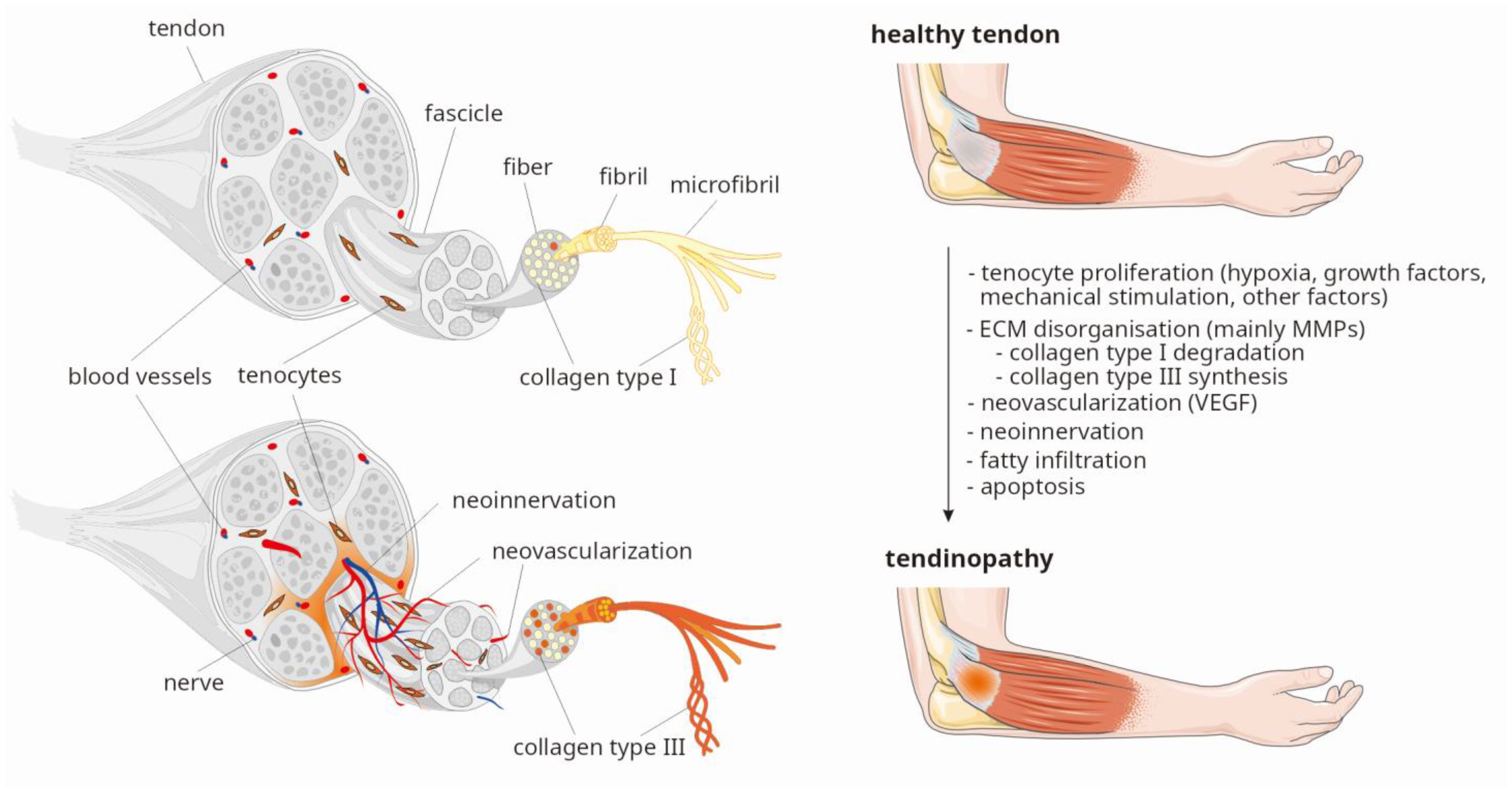
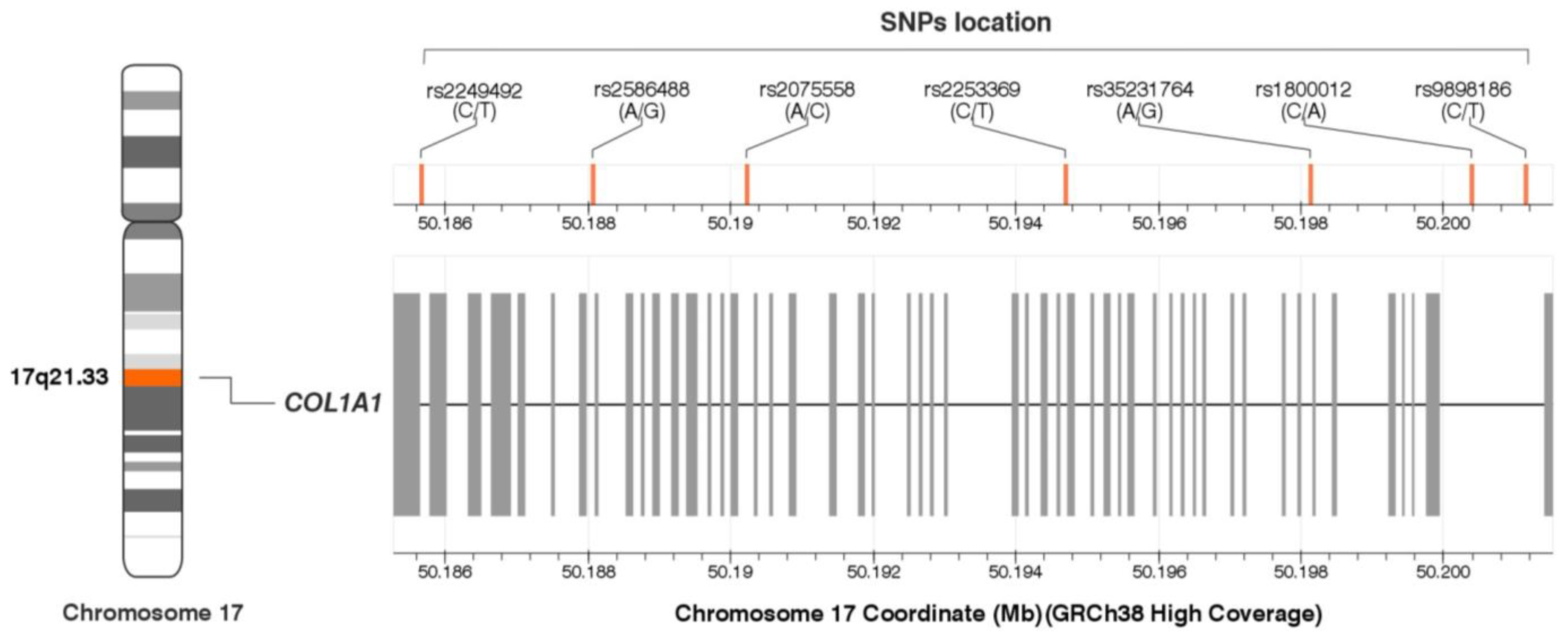

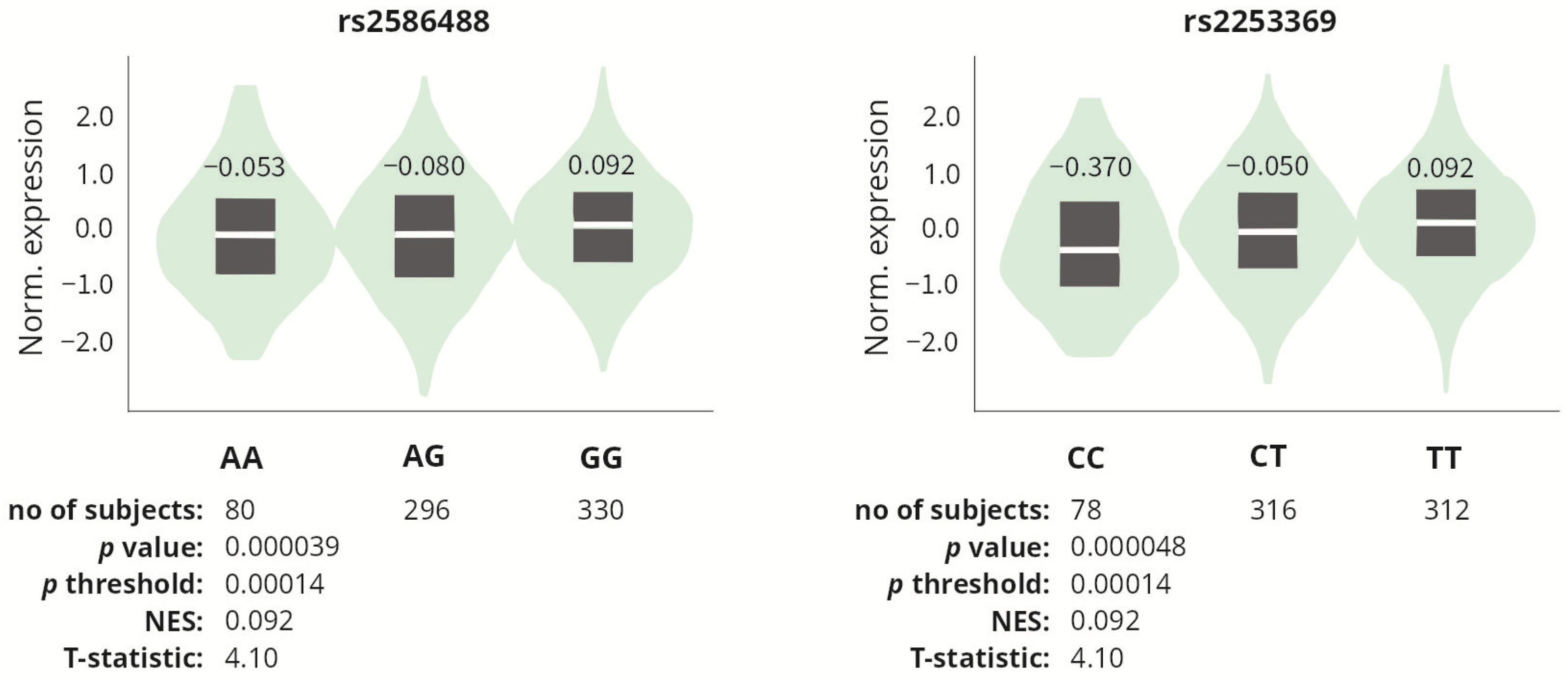
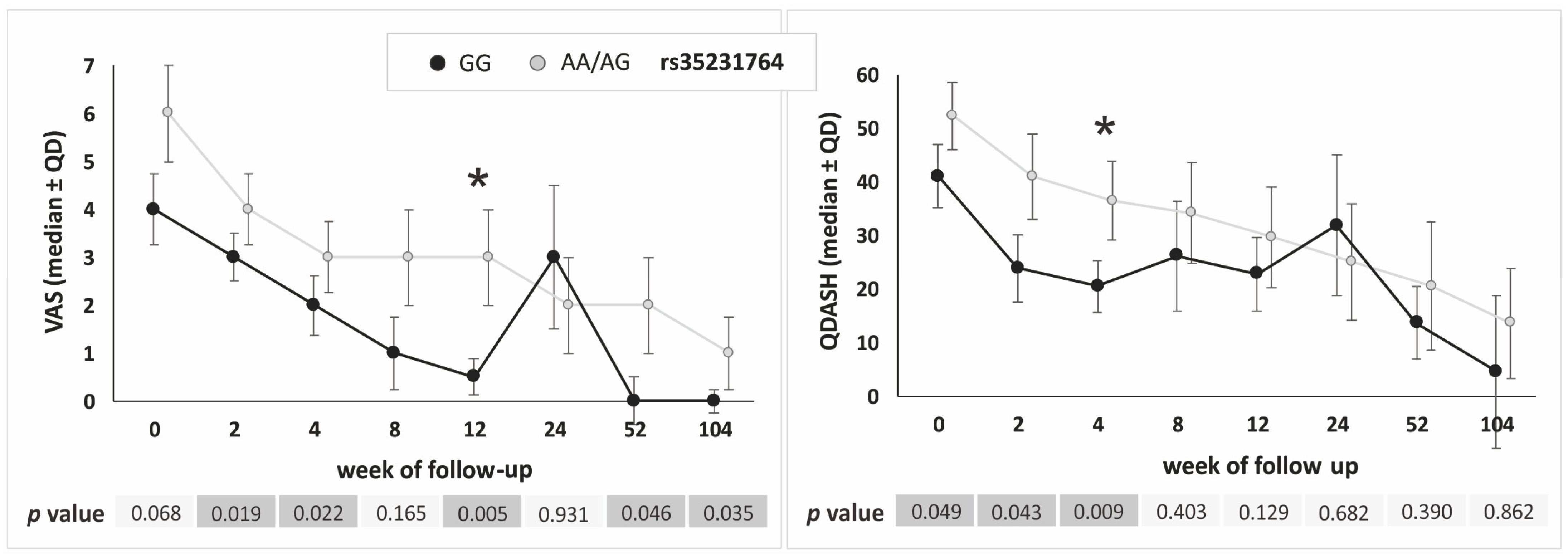
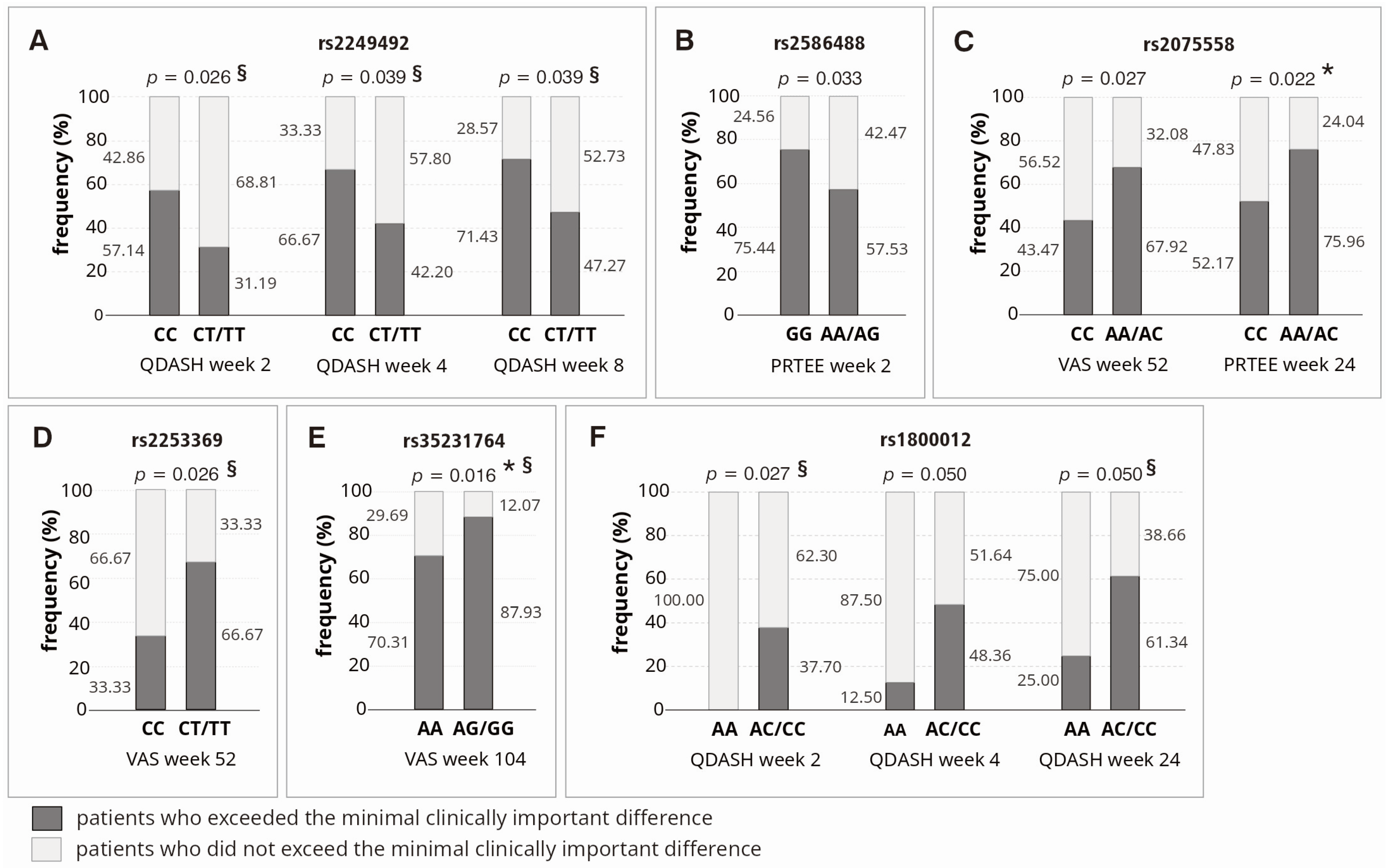
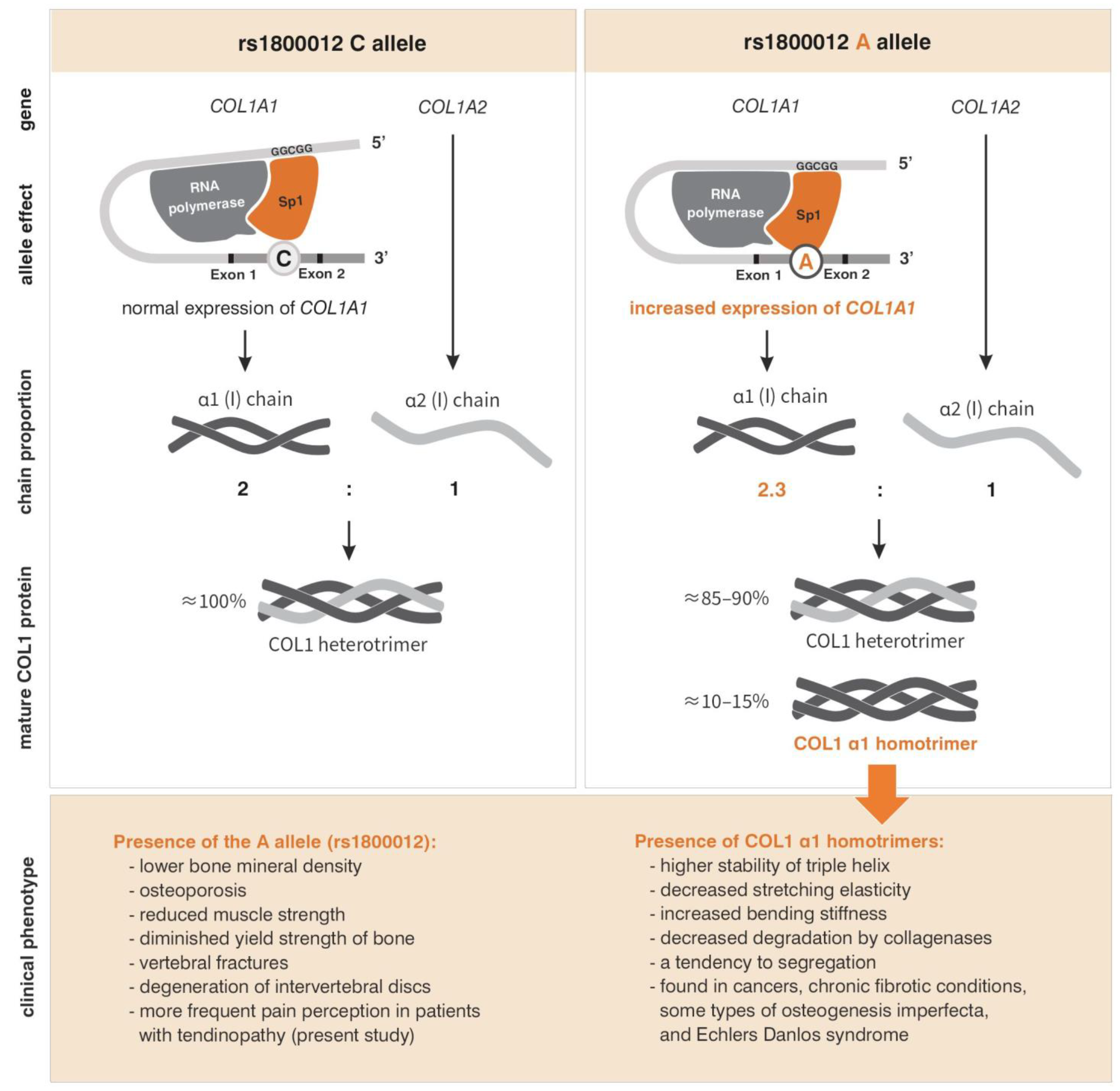
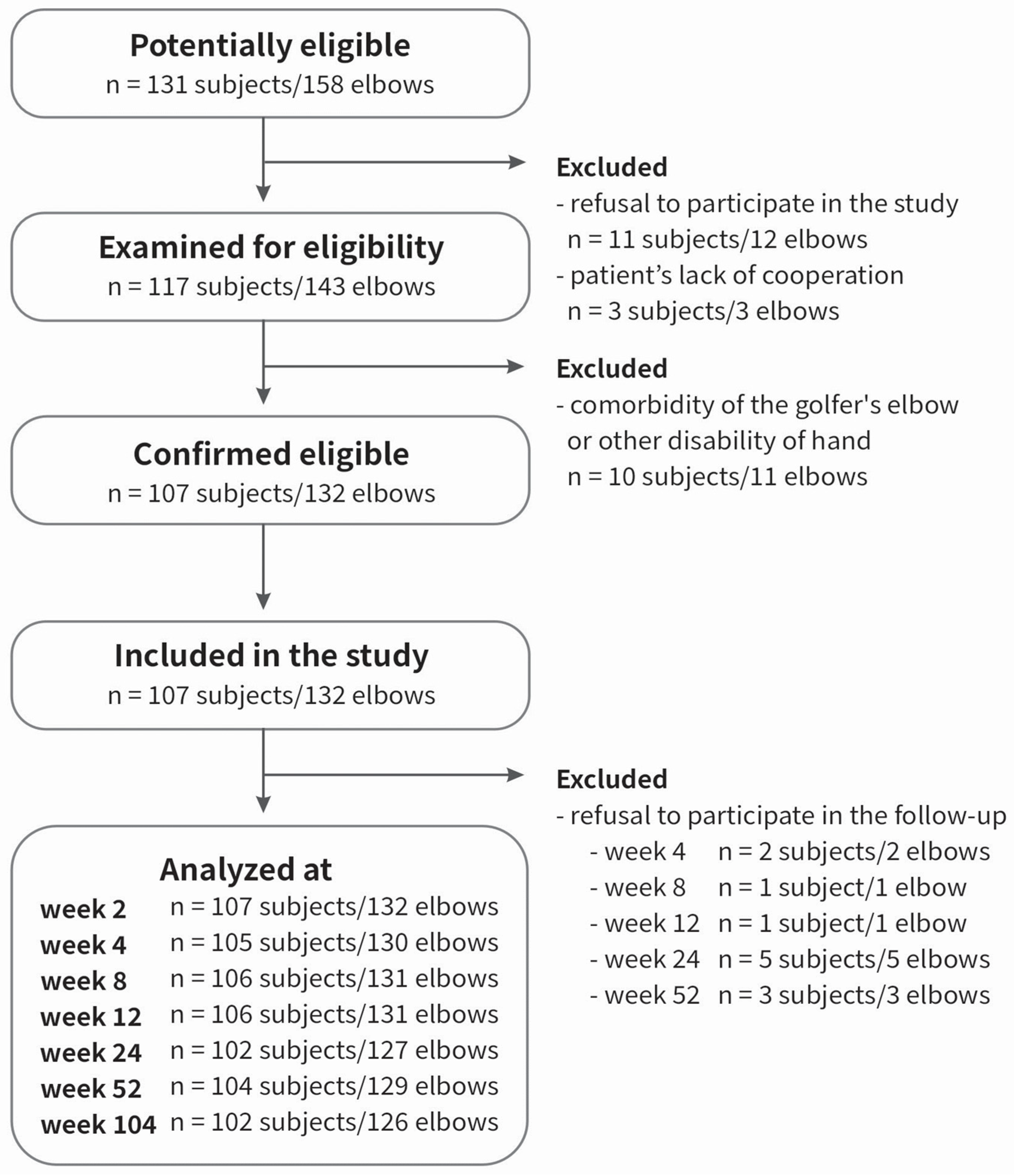
| Characteristics | |||
|---|---|---|---|
| General | number of subjects, N | 107 | - |
| number of elbows, n (%) | 132 | (100.00) | |
| age, median ± QD | 46.00 | 5.50 | |
| BMI, median ± QD | 25.65 | 2.00 | |
| current smokers, n (%) | 22 | (16.67) | |
| Comorbidities | diabetes mellitus, n (%) | 4 | (3.03) |
| gout, n (%) | 8 | (6.06) | |
| obesity (BMI ≥ 30), n (%) | 26 | (19.70) | |
| overweight/obesity (BMI ≥ 25), n (%) | 86 | (65.15) | |
| hypercholesterolemia, n (%) | 10 | (7.58) | |
| hypertension, n (%) | 18 | (13.64) | |
| Pain of elbow | in LE area, n (%) | 132 | (100.00) |
| during the day, n (%) * | 92 | (70.80) | |
| at night, n (%) * | 67 | (51.54) | |
| during lifting, n (%) * | 117 | (90.00) | |
| when grabbing, n (%) * | 80 | (61.54) | |
| when pressing, n (%) * | 85 | (65.39) | |
| when bending the elbow, n (%) * | 92 | (70.77) | |
| when bending the wrist, n (%) * the wrist | 44 | (33.85) | |
| Pain radiating to the | wrist, n (%) * | 40 | (30.77) |
| forearm, n (%) * | 65 | (50.00) | |
| arm, n (%) * | 32 | (24.62) | |
| shoulder, n (%) * | 26 | (20.00) | |
| neck, n (%) * | 12 | (9.23) |
| SNP | Chromosome 17 Coordinate (GRCh38) | Genotypes | n (%) | Alleles | n (%) | p Value HWE Test |
|---|---|---|---|---|---|---|
| rs2249492 | 50,185,660 | CC | 21 (15.91) | C | 104 (39.39) | 0.983 |
| CT | 62 (46.97) | T | 160 (60.61) | |||
| TT | 49 (37.12) | |||||
| rs2586488 | 50,188,065 | AA | 12 (9.09) | A | 87 (32.95) | 0.655 |
| AG | 63 (47.73) | G | 177 (67.05) | |||
| GG | 57 (43.18) | |||||
| rs2075558 | 50,190,224 | AA | 39 (29.55) | A | 148 (56.06) | 0.680 |
| AC | 70 (53.03) | C | 116 (43.94) | |||
| CC | 23 (17.42) | |||||
| rs2253369 | 50,194,694 | CC | 12 (9.09) | C | 83 (31.44) | 0.914 |
| CT | 59 (44.70) | T | 181 (68.56) | |||
| TT | 61 (46.21) | |||||
| rs35231764 | 50,198,128 | AA | 70 (53.03) | A | 190 (71.97) | 0.781 |
| AG | 50 (37.88) | G | 74 (28.03) | |||
| GG | 12 (9.09) | |||||
| rs1800012 | 50,200,388 | AA | 8 (6.06) | A | 49 (18.56) | 0.139 |
| AC | 33 (25.00) | C | 215 (81.44) | |||
| CC | 91 (68.94) | |||||
| rs9898186 | 50,201,146 | CC | 78 (59.09) | C | 200 (75.76) | 0.568 |
| CT | 44 (33.33) | T | 64 (24.24) | |||
| TT | 10 (7.58) |
| SNP | Block Size (kb) | Frequency (%) | |||
|---|---|---|---|---|---|
| rs2249492 | rs2586488 | rs1800012 | rs9898186 | ||
| T | G | - | - | 2 | 0.603 |
| C | A | - | - | 0.341 | |
| C | G | - | - | 0.056 | |
| - | - | C | C | 0 | 0.752 |
| - | - | A | T | 0.192 | |
| - | - | C | T | 0.056 | |
| PROM | Week | Median ± QD | p Value | |||||
|---|---|---|---|---|---|---|---|---|
| rs2249492 | Kruskal-Wallis | CC vs. CT | CC vs. TT | CT vs. TT | ||||
| CC | CT | TT | ||||||
| VAS | 2 | 3.00 ± 1.00 | 5.00 ± 1.50 | 3.00 ± 1.00 | 0.012 | 0.005 | 0.903 | 0.018 |
| 4 | 2.00 ± 1.00 | 4.00 ± 1.50 | 3.00 ± 1.00 | 0.019 | 0.039 | 1.000 | 0.125 | |
| rs2075558 | Kruskal-Wallis | AA vs. AC | AA vs. CC | AC vs. CC | ||||
| AA | AC | CC | ||||||
| ΔVAS | 104 | 5.00 ± 2.00 | 4.00 ± 2.00 | 2.00 ± 3.00 | 0.025 | 0.116 | 0.037 | 0.930 |
| rs35231764 | Kruskal-Wallis | AA vs. AG | AA vs. GG | AG vs. GG | ||||
| AA | AG | GG | ||||||
| VAS | 0 | 5.00 ± 2.00 | 6.00 ± 1.50 | 4.00 ± 1.50 | 0.004 * | 0.018 | 0.843 | 0.026 |
| 2 | 3.00 ± 1.50 | 4.00 ± 1.50 | 3.00 ± 1.00 | 0.006 * | 0.088 | 0.258 | 0.010 | |
| 4 | 3.00 ± 1.50 | 4.00 ± 1.50 | 2.00 ± 1.25 | 0.036 | 0.722 | 0.169 | 0.034 | |
| 12 | 2.00 ± 1.50 | 3.00 ± 2.00 | 0.50 ± 0.75 | 0.007 * | 0.438 | 0.059 | 0.006 | |
| QDASH | 0 | 48.86 ± 11.37 | 59.09 ± 12.50 | 40.91 ± 11.82 | 0.006 * | 0.038 | 0.588 | 0.021 |
| 2 | 36.36 ± 11.36 | 50.00 ± 19.32 | 23.86 ± 12.50 | 0.017 | 0.010 | 0.658 | 0.011 | |
| 4 | 36.36 ± 10.23 | 45.45 ± 15.91 | 20.45 ± 9.66 | 0.012 | 0.482 | 0.084 | 0.010 | |
| PRTEE | 0 | 49.50 ± 10.50 | 63.00 ± 14.00 | 38.75 ± 16.25 | 0.001 * | 0.002 | 1.000 | 0.032 |
| 2 | 29.00 ± 12.25 | 37.00 ± 20.00 | 17.75 ± 3.88 | 0.007 * | 0.086 | 0.291 | 0.012 | |
| rs1800012 | Kruskal-Wallis | AA vs. AC | AA vs. CC | AC vs. CC | ||||
| AA | AC | CC | ||||||
| VAS | 0 | 5.00 ± 1.25 | 7.00 ± 1.50 | 5.00 ± 1.50 | 0.027 | 0.486 | 1.000 | 0.025 |
| 12 | 2.00 ± 1.25 | 4.00 ± 1.50 | 2.00 ± 1.50 | 0.035 | 0.314 | 1.000 | 0.044 | |
| PRTEE | 0 | 41.20 ± 7.63 | 59.00 ± 10.25 | 50.00 ± 14.00 | 0.042 | 0.135 | 1.000 | 0.092 |
| SNP | PROM | Week | Median | ±QD | Median | ±QD | p Value |
|---|---|---|---|---|---|---|---|
| rs2249492 | CC | CT/TT | |||||
| VAS | 2 | 3.00 | 1.00 | 4.00 | 1.50 | 0.017 | |
| ΔQDASH | 2 | 15.91 | 11.36 | 4.54 | 11.37 | 0.038 | |
| rs2586488 | AA | AG/GG | |||||
| QDASH | 0 | 60.22 | 11.47 | 51.14 | 13.64 | 0.039 | |
| rs2075558 | AA | AC/CC | |||||
| VAS | 104 | 0.00 | 1.00 | 1.00 | 1.50 | 0.023 | |
| ΔQDASH | 104 | 5.00 | 2.00 | 3.75 | 2.50 | 0.013 | |
| rs1800012 | CC | AA/AC | |||||
| VAS | 0 | 5.00 | 1.50 | 7.00 | 1.50 | 0.023 | |
| 12 | 2.00 | 1.50 | 4.00 | 1.50 | 0.048 | ||
| 24 | 2.00 | 2.00 | 3.00 | 2.25 | 0.018 | ||
| QDASH | 12 | 25.00 | 17.05 | 34.09 | 17.05 | 0.041 | |
| PRTEE | 2 | 25.00 | 16.00 | 38.50 | 14.00 | 0.035 | |
| Pain | SNP | Genotypes, n (%) | p Value for Models | ||||
|---|---|---|---|---|---|---|---|
| Additive | Recessive–Dominant | ||||||
| rs2249492 | CC | CT | TT | CT/TT vs. CC | |||
| during lifting | Yes | 15 (71.43) | 58 (95.08) | 44 (91.67) | 0.007 * | 0.007 1,* § | |
| No | 6 (28.57) | 3 (4.92) | 4 (8.33) | ||||
| rs2586488 | AA | AG | GG | AA/AG vs. GG | |||
| of arm | Yes | 6 (50.00) | 17 (27.42) | 9 (16.07) | 0.036 | 0.049 | |
| No | 6 (50.00) | 45 (72.58) | 47 (83.93) | ||||
| rs2075558 | AA | AC | CC | AC/CC vs. AA | |||
| of arm | Yes | 5 (13.16) | 24 (34.78) | 3 (13.04) | 0.017 | 0.008 § | |
| No | 33 (86.84) | 45 (65.22) | 20 (86.96) | ||||
| of neck | Yes | 0 (0.00) | 11 (15.94) | 1 (4.35) | 0.016 * | 0.013 2,* § | |
| No | 38 (100.00) | 58 (84.06) | 22 (95.65) | ||||
| when grabbing | Yes | 18 (47.37) | 49 (71.01) | 13 (56.52) | 0.048 | 0.033 § | |
| No | 20 (52.63) | 20 (28.99) | 10 (43.48) | ||||
| rs35231764 | AA | AG | GG | AG/GG vs. AA | |||
| of arm | Yes | 22 (32.35) | 9 (18.00) | 1 (8.33) | ns | 0.032 | |
| No | 46 (67.65) | 41 (82.00) | 11 (91.67) | ||||
| rs1800012 | AA | AC | CC | AA/AC vs. CC | |||
| at night | Yes | 5 (71.43) | 25 (78.13) | 37 (40.66) | 0.000 * | 0.000 3,* § | |
| No | 2 (28.57) | 7 (21.88) | 54 (59.34) | ||||
| during the day | Yes | 6 (85.71) | 28 (87.50) | 58 (63.74) | 0.026 | 0.007 4,* § | |
| No | 1 (14.29) | 4 (12.50) | 33 (36.26) | ||||
| rs9898186 | CC | CT | TT | CT/TT vs. CC | |||
| at night | Yes | 33 (42.31) | 27 (62.79) | 7 (77.78) | 0.026 | 0.010 5,* | |
| No | 45 (57.69) | 16 (37.21) | 2 (22.22) | ||||
| of shoulder | Yes | 9 (11.54) | 11 (25.58) | 6 (66.67) | ns | 0.044 | |
| No | 69 (88.46) | 32 (74.42) | 3 (33.33) | ||||
| of forearm | Yes | 37 (47.44) | 20 (46.51) | 8 (88.98) | TT vs. CC/CT | ||
| No | 41 (52.56) | 23 (53.49) | 1 (11.11) | ns | 0.016 6,* § | ||
| when bending the wrist | Yes | 25 (32.05) | 13 (30.23) | 6 (66.67) | |||
| No | 53 (67.95) | 30 (69.77) | 3 (33.33) | ns | 0.040 § | ||
Disclaimer/Publisher’s Note: The statements, opinions and data contained in all publications are solely those of the individual author(s) and contributor(s) and not of MDPI and/or the editor(s). MDPI and/or the editor(s) disclaim responsibility for any injury to people or property resulting from any ideas, methods, instructions or products referred to in the content. |
© 2024 by the authors. Licensee MDPI, Basel, Switzerland. This article is an open access article distributed under the terms and conditions of the Creative Commons Attribution (CC BY) license (https://creativecommons.org/licenses/by/4.0/).
Share and Cite
Niemiec, P.; Jarosz, A.; Nowak, T.; Balcerzyk-Matić, A.; Iwanicki, T.; Iwanicka, J.; Gawron, K.; Kalita, M.; Górczyńska-Kosiorz, S.; Kania, W.; et al. Impact of the COL1A1 Gene Polymorphisms on Pain Perception in Tennis Elbow Patients: A Two-Year Prospective Cohort Study. Int. J. Mol. Sci. 2024, 25, 13221. https://doi.org/10.3390/ijms252313221
Niemiec P, Jarosz A, Nowak T, Balcerzyk-Matić A, Iwanicki T, Iwanicka J, Gawron K, Kalita M, Górczyńska-Kosiorz S, Kania W, et al. Impact of the COL1A1 Gene Polymorphisms on Pain Perception in Tennis Elbow Patients: A Two-Year Prospective Cohort Study. International Journal of Molecular Sciences. 2024; 25(23):13221. https://doi.org/10.3390/ijms252313221
Chicago/Turabian StyleNiemiec, Paweł, Alicja Jarosz, Tomasz Nowak, Anna Balcerzyk-Matić, Tomasz Iwanicki, Joanna Iwanicka, Katarzyna Gawron, Marcin Kalita, Sylwia Górczyńska-Kosiorz, Wojciech Kania, and et al. 2024. "Impact of the COL1A1 Gene Polymorphisms on Pain Perception in Tennis Elbow Patients: A Two-Year Prospective Cohort Study" International Journal of Molecular Sciences 25, no. 23: 13221. https://doi.org/10.3390/ijms252313221
APA StyleNiemiec, P., Jarosz, A., Nowak, T., Balcerzyk-Matić, A., Iwanicki, T., Iwanicka, J., Gawron, K., Kalita, M., Górczyńska-Kosiorz, S., Kania, W., & Szyluk, K. (2024). Impact of the COL1A1 Gene Polymorphisms on Pain Perception in Tennis Elbow Patients: A Two-Year Prospective Cohort Study. International Journal of Molecular Sciences, 25(23), 13221. https://doi.org/10.3390/ijms252313221








